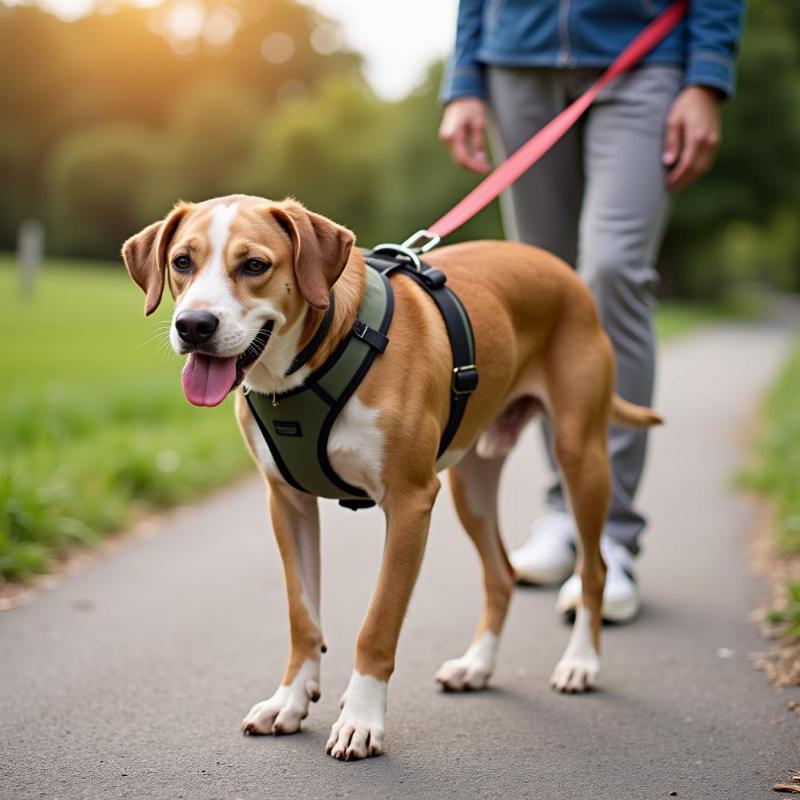Arthritis can significantly impact a dog’s mobility and quality of life. A dog harness for arthritic dogs can be a game-changer, offering support, reducing pain, and helping them maintain their independence. Choosing the right harness is crucial for maximizing comfort and minimizing strain on affected joints. This guide will help you understand the benefits of using a harness for arthritic dogs and how to select the perfect one for your furry friend.
Why Use a Dog Harness for Arthritic Dogs?
Traditional collars put pressure on a dog’s neck, which can exacerbate arthritis pain, particularly in the neck and spine. Harnesses distribute pressure more evenly across the body, reducing strain on sensitive areas. This is especially beneficial for dogs with arthritis in their neck, shoulders, or front legs. A harness also provides better control and stability, reducing the risk of falls or slips, which can be particularly dangerous for arthritic dogs. They make walks more comfortable and enjoyable, encouraging much-needed exercise for maintaining joint health and overall well-being.
 Harness supporting an arthritic dog
Harness supporting an arthritic dog
Choosing the Right Harness: Features to Consider
Several factors determine the best dog harness for arthritic dogs. Consider these key features:
- Padding and Material: Look for harnesses made of soft, breathable materials like padded nylon or neoprene. Ample padding around the chest and back provides extra comfort and minimizes rubbing or chafing on sensitive skin.
- Easy On/Off Design: Arthritic dogs may have difficulty with traditional step-in harnesses. Front-clip or lift-and-support harnesses are easier to put on and take off, minimizing discomfort for your dog.
- Support and Stability: Harnesses with handles offer additional support, especially for dogs struggling to stand or walk. Some harnesses even have lift straps to help you assist your dog up stairs or into cars.
- Adjustability: A properly fitted harness is essential for comfort and effectiveness. Look for harnesses with multiple adjustment points to ensure a snug, secure fit without restricting movement.
Types of Harnesses for Arthritic Dogs
harness for dogs with arthritis come in various styles, each with its own advantages:
- Front-Clip Harnesses: These harnesses clip in the front, discouraging pulling and providing more control over your dog’s movements. This can be particularly helpful for arthritic dogs who may be prone to sudden lunges or changes in direction.
- Lift-and-Support Harnesses: These harnesses feature handles and straps specifically designed to support your dog’s weight, making it easier for them to stand, walk, and navigate stairs or other obstacles. They are ideal for dogs with significant mobility limitations.
- Step-in Harnesses: While not always the easiest to put on arthritic dogs, step-in harnesses can be a good option if your dog tolerates them. Look for styles with wide openings and adjustable straps for a comfortable fit.
Tips for Using a Harness with Your Arthritic Dog
- Introduce the Harness Gradually: Allow your dog to get used to the harness slowly. Start by putting it on for short periods and rewarding them with treats and praise.
- Ensure a Proper Fit: A harness that is too tight can restrict movement and cause discomfort, while a loose harness can be ineffective and even dangerous. Make sure the harness fits snugly but allows for two fingers to fit comfortably between the harness and your dog’s body.
- Monitor Your Dog’s Comfort: Pay attention to your dog’s body language while they are wearing the harness. If they seem uncomfortable or restless, adjust the fit or try a different style.
- Consult Your Veterinarian: If you are unsure which type of harness is best for your dog, talk to your veterinarian. They can provide recommendations based on your dog’s specific needs and condition.
Conclusion
A dog harness for arthritic dogs can significantly improve their mobility, comfort, and overall quality of life. By choosing the right harness and using it correctly, you can help your furry friend stay active and enjoy their walks, even with arthritis. Remember to prioritize comfort, support, and ease of use when making your selection.
FAQ
- Can a harness help my dog with hip dysplasia? Yes, a harness can distribute weight away from the hips, providing relief and improving mobility.
- What type of harness is best for a dog with neck arthritis? Front-clip or lift-and-support harnesses are generally recommended for dogs with neck arthritis.
- How do I know if the harness fits my dog correctly? You should be able to fit two fingers comfortably between the harness and your dog’s body.
- Are harnesses better than collars for arthritic dogs? Generally, yes, as harnesses distribute pressure more evenly and reduce strain on sensitive joints.
- Where can I buy a harness for my arthritic dog? Pet stores, online retailers, and veterinary clinics typically carry a variety of harnesses.
- Can a harness help prevent further joint damage? While a harness cannot prevent arthritis progression, it can reduce strain on joints and minimize discomfort, which can contribute to a better quality of life.
- How do I clean my dog’s harness? Most harnesses can be hand-washed or machine-washed on a gentle cycle. Follow the manufacturer’s instructions for specific cleaning recommendations.
Beautdogs.us is your premier resource for all things dog-related in the US. We offer expert advice on dog breeds, care, and products, catering to both novice and experienced dog owners. Our mission is to empower you to provide the best possible care for your canine companion. For further assistance, please reach out to us via email at [email protected] or by phone at +1 501-555-7529. Visit Beautdogs.us for more valuable insights and expert guidance on dog care.